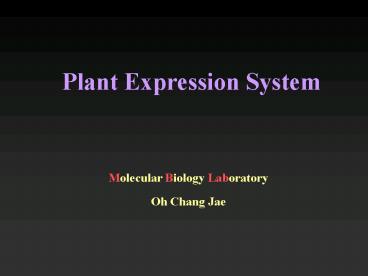Plant Expression System - PowerPoint PPT Presentation
1 / 12
Title: Plant Expression System
1
Plant Expression System
Molecular Biology Laboratory Oh Chang Jae
2
Overview of methods for plant transformation
A. Delivery of DNA into a single plant cell
? transient assay B. Integration of DNA into the
plant cell genome C. Regeneration of the
transformed cell into a whole plant
3
In planta transformation with Agrobacterium
Vacuum infiltration (Bechtold et al. 1993
) Floral dipping method (Bent et al.,
1998) Co-cultivation
with Agrobacterium
4
Agrobacterium tumefaciens
- crown gall disease
- Ti plasmid T-DNA vir genes
( gt 200 Kbp )
5
Host Range cause disease primarily on dicots.
However, they can even infect gymnosperms,
not infectious on monocots, although transfer of
the T-DNA into monocot can occur.
Pathogenesis
1. Tumor formation caused by the elevation of
auxin and cytokinin levels by genes on a natural
T-DNA 2. Opines synthesis
T-DNA used for scientific experimentation have
usually been deleted of iaaM, iaaH, ipt and opine
synthesis genes. ? disarmed
6
T-DNA transfer as mediated by vir gene functions
7
Plant transformation vector
Binary vector system - Basic cloning vector
(plant expression vector) - plant
transformation vector
Cointegrate vector system - Cointegrate
vector - Disarmed Ti plasmid
8
General Vector composition
v T-DNA cassette
Ti-plasmid right border (RB) MCS positive
selectable marker Ti-plasmid left border (LB)
v Promoter
Constitutve 35S CaMV (Cauliflower mosaic
virus) Inducible heat shock, glucocorticoid
hormones, alcohol etc. A plant promoter will
often work in many different plant species, but
yeast or human or bacterial promoter do not
function.
v Terminator
Derived from CaMV, nopaline synthase gene etc.
v Common plant selectable marker antibiotics ,
herbicides
9
Schematic diagram of binary vector
10
Basic cloning vector (pRT101)
P35S CaMV 35S Promoter
pACaMV CaMV polyadenylation site
ColE1 replication origin
bla Amp resistance gene
11
(No Transcript)
12
Plant transformation vector (pBIN20)
Kanamycine Resistance
NOS promoter
NOS terminator
Border































